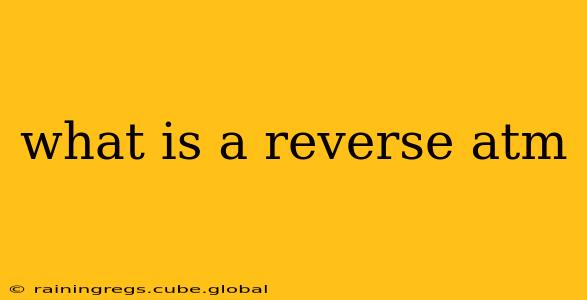A reverse ATM, also known as a cash deposit ATM, cash recycler, or cash acceptance kiosk, allows you to deposit cash directly into your bank account without needing a human teller. Instead of withdrawing money, you're depositing it. Think of it as the opposite of a traditional ATM – hence the name "reverse ATM."
These machines are becoming increasingly common, offering a convenient alternative to traditional banking methods. They're designed to streamline cash deposits, saving you time and effort. But how do they work, and what are the benefits? Let's dive in.
How Does a Reverse ATM Work?
The process is usually straightforward:
- Insertion: You insert your cash into the machine, typically in bundles or individually, depending on the machine's design. Some machines have dedicated slots for different denominations.
- Authentication: You'll need to authenticate yourself, usually via your bank card and PIN, or sometimes through a mobile banking app. This ensures the deposit is correctly linked to your account.
- Counting and Verification: The machine counts the cash using sophisticated image recognition and counting technology. It verifies the authenticity of the banknotes to detect counterfeits.
- Deposit Confirmation: Once the machine confirms the count and authenticity, the deposit is processed and credited to your account. You usually receive an on-screen confirmation, and in many cases, a receipt.
What are the Benefits of Using a Reverse ATM?
- Convenience: Deposit cash at your convenience, 24/7, often located in more accessible places than bank branches.
- Speed: Deposits are typically processed much faster than through a traditional teller.
- Security: Reverse ATMs often employ advanced security measures to protect against theft and fraud.
- Reduced Bank Branch Visits: Less need to visit busy bank branches, saving you time and potentially avoiding queues.
- Accessibility: Available in locations where traditional banks may not have a physical presence.
What are the Different Types of Reverse ATMs?
While the core function remains the same, there are variations in how reverse ATMs operate:
- Standalone Machines: These are independent units, often located in high-traffic areas like shopping malls or gas stations.
- Integrated ATMs: Some ATMs combine traditional cash withdrawal functionality with cash deposit capabilities.
Are Reverse ATMs Safe?
Modern reverse ATMs incorporate multiple security measures to protect against fraud and theft, including:
- Counterfeit Detection: Sophisticated technology identifies counterfeit banknotes.
- Surveillance Cameras: Many machines have cameras to deter and record any suspicious activity.
- Secure Enclosures: The cash handling mechanisms are usually protected within a secure enclosure.
- Encryption: Data transmitted between the machine and your bank is encrypted to protect your information.
What Fees are Associated with Using a Reverse ATM?
Fees can vary depending on your bank and the specific reverse ATM provider. Some banks may offer free deposits, while others may charge a fee, particularly if the machine is operated by a third-party provider. It's essential to check with your bank before using a reverse ATM to avoid unexpected charges.
Can I Deposit Checks Using a Reverse ATM?
No, generally, reverse ATMs are only designed to accept cash. Check deposits usually require a traditional teller or mobile check deposit through your banking app.
Where Can I Find a Reverse ATM Near Me?
Many banks and financial institutions now offer reverse ATM services. You can typically locate them using your bank's mobile app or website, or by searching online for "reverse ATM near me."
By understanding how reverse ATMs operate and their associated benefits and limitations, you can leverage this convenient banking tool to manage your finances more efficiently. Remember to always check with your bank for specific details regarding fees and supported functionalities.
